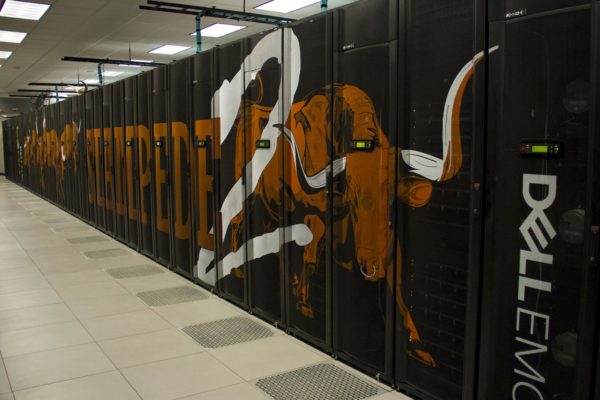AUSTIN, Texas — The Texas Advanced Computing Center (TACC) at The University of Texas at Austin has launched Stampede2, the most powerful supercomputer at any U.S. university and one of the most powerful in the world.
“For 16 years, the Texas Advanced Computing Center has earned its reputation for innovation and technological leadership,” said Gregory L. Fenves, president of UT Austin. “It is only fitting that TACC has designed and now operates the most powerful supercomputer at any university in the U.S., enabling scientists and engineers to take on the greatest challenges facing society.”
Made possible by a $30 million award from the National Science Foundation, Stampede2 is the newest strategic resource for the nation’s academic community and will enable researchers nationwide from all disciplines to answer questions that cannot be addressed through theory or experimentation alone and that require high-performance computing power.
Researchers will be able to use a wide range of applications, from large-scale simulations and data analyses using thousands of processors simultaneously, to smaller computations or interacting with Stampede2 through web-based community platforms.
“Stampede2 represents a new horizon for academic researchers,” said Dan Stanzione, TACC’s executive director. “It will serve as the workhorse for our nation’s scientists and engineers, allowing them to improve our competitiveness and ensure that UT Austin remains a leader in computational research for the national open science community.”
Phase 1 of the system, which is complete, ranked as the 12th most powerful supercomputer in the world on the June Top500 list. Later this summer, Phase 2 will add additional hardware and processors, giving it a peak performance of 18 petaflops, or 18 quadrillion mathematical operations per second. The system will have about the equivalent processing power of 100,000 desktop computers — one for every seat in UT Austin’s Darrell K Royal-Texas Memorial Stadium.
Stampede2 will be the largest supercomputing resource available to researchers through the NSF-supported Extreme Science and Engineering Discovery Environment, which will allocate time on the supercomputer to researchers based on a competitive peer-review process.
“NSF is proud to join with UT Austin in supporting the nation’s academic researchers in science and engineering with the latest in advanced computing technology and expertise,” said Irene Qualters, NSF division director for advanced cyberinfrastructure. “Stampede2’s capabilities will complement and significantly expand the diverse portfolio of computing resources increasingly essential to exploration at the frontiers of science and engineering.”
The system continues the important service to the scientific community provided by Stampede1 — also supported by NSF — which operated from 2013 to 2017 at TACC. Over the course of its existence, that system ran 8 million compute jobs in support of tens of thousands of researchers and more than 3,000 science and engineering projects.
Stampede2 will double the peak performance, memory, storage capacity and bandwidth of its predecessor, but it will occupy half as much physical size and consume half as much power. It will be integrated into TACC’s ecosystem of more than 15 advanced computing systems, providing access to long-term storage, scientific visualization, machine learning and cloud computing capabilities. In addition to its massive scale, the new system will be among the first to employ the most advanced computer processor, memory, networking and storage technology from its industry partners DELLEMC, Intel and Seagate.
TACC staff members worked since January to construct Stampede2 in TACC’s data center, and they deployed the system ahead of schedule. Since April, researchers have used the system to conduct large-scale scientific studies of gravitational waves, earthquakes, nanoparticles, cancer proteins and severe storms.
A number of universities will collaborate with TACC to provide cyberinfrastructure expertise and services for Stampede2. The partner institutions are Clemson University, Cornell University, Indiana University, Ohio State University and the University of Colorado.
The system comes online at a time when the use of NSF-supported research cyberinfrastructure resources is at an all-time high across all science and engineering disciplines. Since 2005, the number of active institutions using research cyberinfrastructure has doubled, the number of principal investigators has tripled, and the number of active users has quintupled.
“Stampede2 will help a growing number of scientists access computation at scale, powering discoveries that change the world,” Stanzione said.
Video is available here: https://youtu.be/HoGek4lgl-M.




